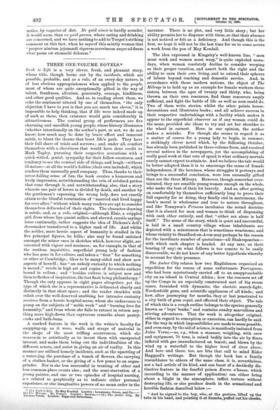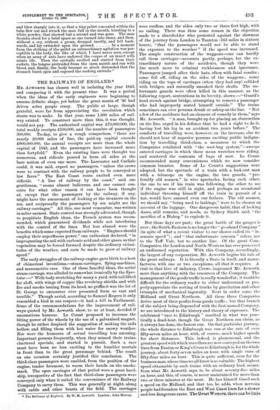THREE ONE-VOLUME NOVELS.*
Such. is Life is a very clever, fresh, and pleasant story, whose title, though borne out by the incidents, which are possible, probable, and as a rule, of an every-day nature, is of less obvious appropriateness when applied to the people, most of whom are quite exceptionally gifted in the way of talent, frankness, altruism, generosity, courage, kindliness, and other good qualities. And as, in reading about them, we echo the sentiment uttered by one of themselves, "the only objection I have to you is that you are much too clever," it is impossible to help thinking, that if life were indeed made up of such as these, then existence would gain considerably in attractiveness. The central group of performers are five charming and unselfish young people, whose history illustrates (whether intentionally on the author's part, or not, we do not know) how much may be done by brave effort and innocent mirth, to blunt the thorns that beset life's path. They have their full share of trials and sorrows ; and, under all, comfort themselves with a cheeriness that would have done credit to Mark Tapley, pursuing their respective avocations with a quick-witted, genial, sympathy for their fellow-creatures, and tendency to see the comical side of things, and laugh—without ill-nature—at all the world's foibles (their own included), which renders them unusually good company. Thus, thanks to their never-failing sense of fun, the book creates a humorous and lively impression, notwithstanding the vein of subdued pathos that runs through it, and notwithstanding, also, that a story wherein one pair of lovers is divided by death, and another by the gentleman's espousing the wrong lady, does not exactly attain to the blissful termination of "married and lived happy for ever after," without which many readers are apt to consider themselves defrauded of their rights. The character-drawing is subtle, and, as a rule, original,—although Elsie, a crippled girl, from whose lips quaint sallies, and shrewd, caustic sayings issue continually, rather suggests the idea of Dickens's doll's dressmaker transferred to a higher rank of life. And whilst the nobler, more heroic aspect of humanity is studied in the five principal figures, its follie3 also may be found satirised amongst the minor ones in sketches which, however slight, are executed with vigour and neatness; as, for example, in that of the restless, inquisitive, superficial young lady of fashion who has gone in for culture, and taken a " first " for something or other at Cambridge; likes to be many-sided and show new aspects of herself; has "an unholy curiosity to which nothing is sacred ;" revels in high art and copies of favourite authors bound in vellum ; and "besides culture is subject now and then to flashes of inspiration, the last flash being philanthropy." Though she only appears in eight pages altogether, yet the type of which she is a representative is delineated clearly and distinctly in that short space ; and the reader chuckles with relish over the well-deserved snubbing her intrusive curiosity receives from a heroic hospital-nurse, whom she endeavours to pump on the subjects of "noble work" and "burning love for humanity," and from whom she fails to extract in return any- thing more high-flown than rapturous remarks about pastry. cooks and bath-buns.
A marked feature in the work is the writer's faculty for snapping-up, as it were, waifs and strays of material in the shape of the most trifling occurrences, which she weaves-in so artistically as to invest them with unexpected interest, and make them bring out the individualities of the different actors, and assist in giving an air of reality. In this manner are utilised homely incidents, such as the upsetting of a water-jug, the purchase of a bunch of flowers, the carrying of a clothes-basket, or the giving of a few pence to an organ.. grinder. Nor is she less successful in treating of other and leas common-place events also; and the semi-starvation of a young painter, and one or two episodes of hospital nursing, we related so graphically as to indicate either personal experience, or else imaginative powers of no mean order in the
• (1.) Such is Life. By May Kendall. London : Longmans, Green, and Co.— (2.) The Milroy& By Nomad. London : Beeton.—(3.) The Amber City. By Thomas Vetch. London: Bina and Debenha.m.
narrator. There is no plot, and very little story ; but her ability permits her to dispense with these, so that their absence is not noticed or felt as a deficiency. And though this is the first, we hope it will not be the last time for us to come across a work from the pen of May Kendall.
The idea expressed in Kingsley's well-known line, "men must work and women must weep," is quite exploded nowa- days, when women resolutely decline to consider weeping as their proper vocation, and assert both the right and the ability to earn their own living, and to extend their spheres of labour beyond teaching and domestic service. And, in accordance with these modern notions, the object of The litilroys is to hold up as an example for female workers three sisters, between the ages of twenty and thirty, who, being thrown on their own resources, find those resources amply sufficient, and fight the battle of life as well as men could do. Two of them write stories, whilst the other paints house- decorations and illustrates books ; and all achieve success in their respective undertakings with a facility which makes it appear to the superficial observer as if any woman could do the same, provided she chose to try and set her shoulder to the wheel in earnest. Here, in our opinion, the author makes a mistake. For though she seems to regard it as a matter of course for a young lady to begin, in summer, a strikingly clever novel which, by the following October, has already been published in three-volume form, and received several notices in the newspapers, yet the accomplishing of really good work at that rate of speed is what ordinary mortals surely cannot expect to attain to. And we believe the tale would be better adapted than it is to encourage the cause of female independence, if the heroines, whose struggles it portrays and brings to a successful conclusion, were less unusually gifted than are the three Milroys. However, though somewhat over- talented, they are sensible young women enough on the whole, who make the best of their lot bravely. And as, after getting on comfortably by themselves sufficiently long to prove their full capacity for so doing, they finally end in matrimony, the book's moral is wholesome and true to nature throughout, and like Tennyson's Princess inculcates the sound doctrine that it is absurd for men and women to think of dispensing with each other entirely, and that "either sex alone is half itself." The scene of the story, which is quiet and uneventful, is laid in a small country village whose inhabitants are depicted with a minuteness that is sometimes wearisome, and whose vicinity to Stratford-on-Avon may perhaps be the reason for the inordinate number of quotations—all Shakespearian— with which each chapter is headed. At any rate, as their bearing (if any) on what follows is too remote to be easily discoverable, we do not know of any better hypothesis whereby to account for their presence.
The Amber City relates how two Englishmen organised an expedition for the rescue of some unfortunate Portuguese, who had been mysteriously carried off to an unapproachable city on an island in Central Africa ; how the rescuers set off up the Congo in an especially constructed sort of big steam canoe, furnished with dynamite, the electric search-light, Nordenfeldt guns, and scientific appliances of all kinds; and how, after journeying for months, they at last penetrated to a city built of gum copal, and effected their object. The tale of which this is a rough outline belongs to the species generally known as "boys' books," and contains sundry marvellous and stirring adventures. That the work is altogether original, either in regard to conception or execution, can hardly be said. For the way in which impossibilities are made to seem possible, and even easy, by the aid of science, is manifestly imitated from Jules Verne,—as, e.g., when a steamer, weighing, with crew and equipment, 70 tons, is raised bodily into the air by floats inflated with gas (manufactured on board), and blown by the wind up a waterfall to the higher level of river above. And here and there, too, are bits that call to mind Rider Haggard's writings. But though the book has a family resemblance to others of the same class, it is, nevertheless, not a bad article of its kind, and can boast of a decidedly dis- tinctive feature in the fearful poison Sur= n'kanza, which (according to the manner of application) can either bring about a blight in the atmosphere, inflict torture without destroying life, or else produce death in the sensational and horrible fashion described below :— "And he signed to the boy, who, at the gesture, lifted up the tube in his hand, and pointing it at Soomba, puffed out his cheeks,
and blew sharply into it, so that a tiny pellet concealed within the tube flew out and struck the man full in the mouth, bursting to a white powder, that showed but a second and was gone. The man Soomba stood for a brief space as one turned into stone, and then, without a cry, without a groan, dropped inertly, and fell back- wards, and lay extended upon the ground In a moment from the striking of the pellet an extraordinary agitation was per- ceptible in the body, the like of which I have never seen, except when an army of ants have endowed the corpse of an insect with mimic life. Then the eyeballs swelled and started from their sockets, the tongue protruded from the open mouth and ran with blood, and, finally, the body became so much distended that the stomach burst open and exposed the reeking entrails."



















































 Previous page
Previous page